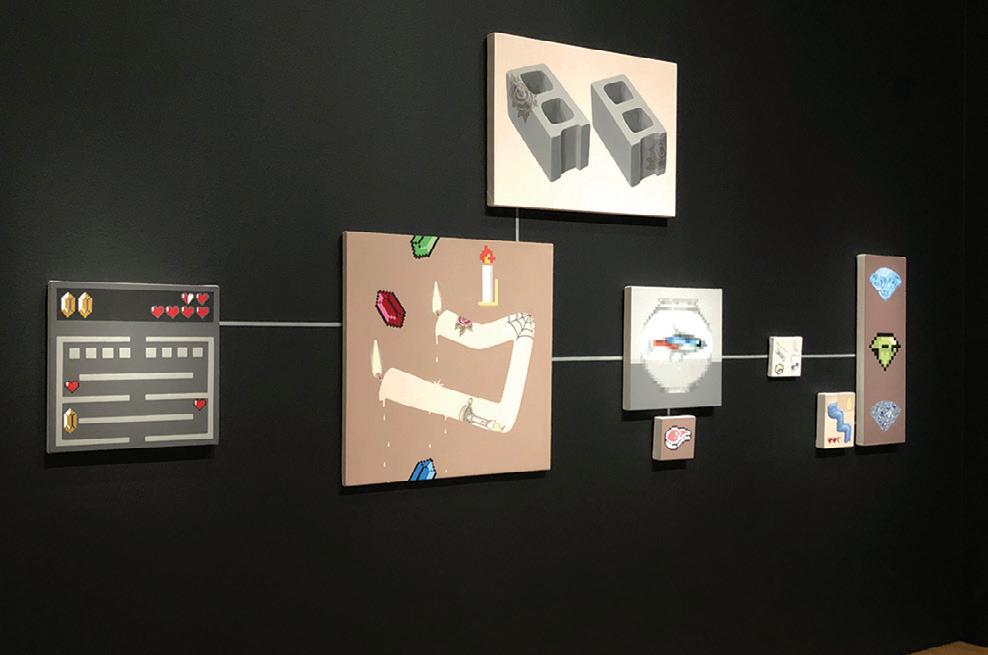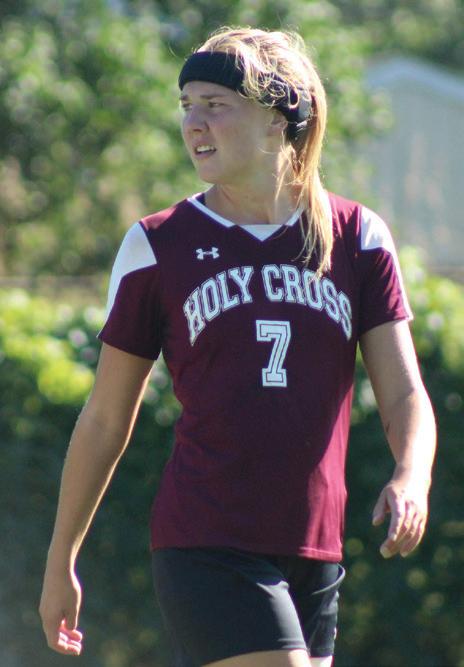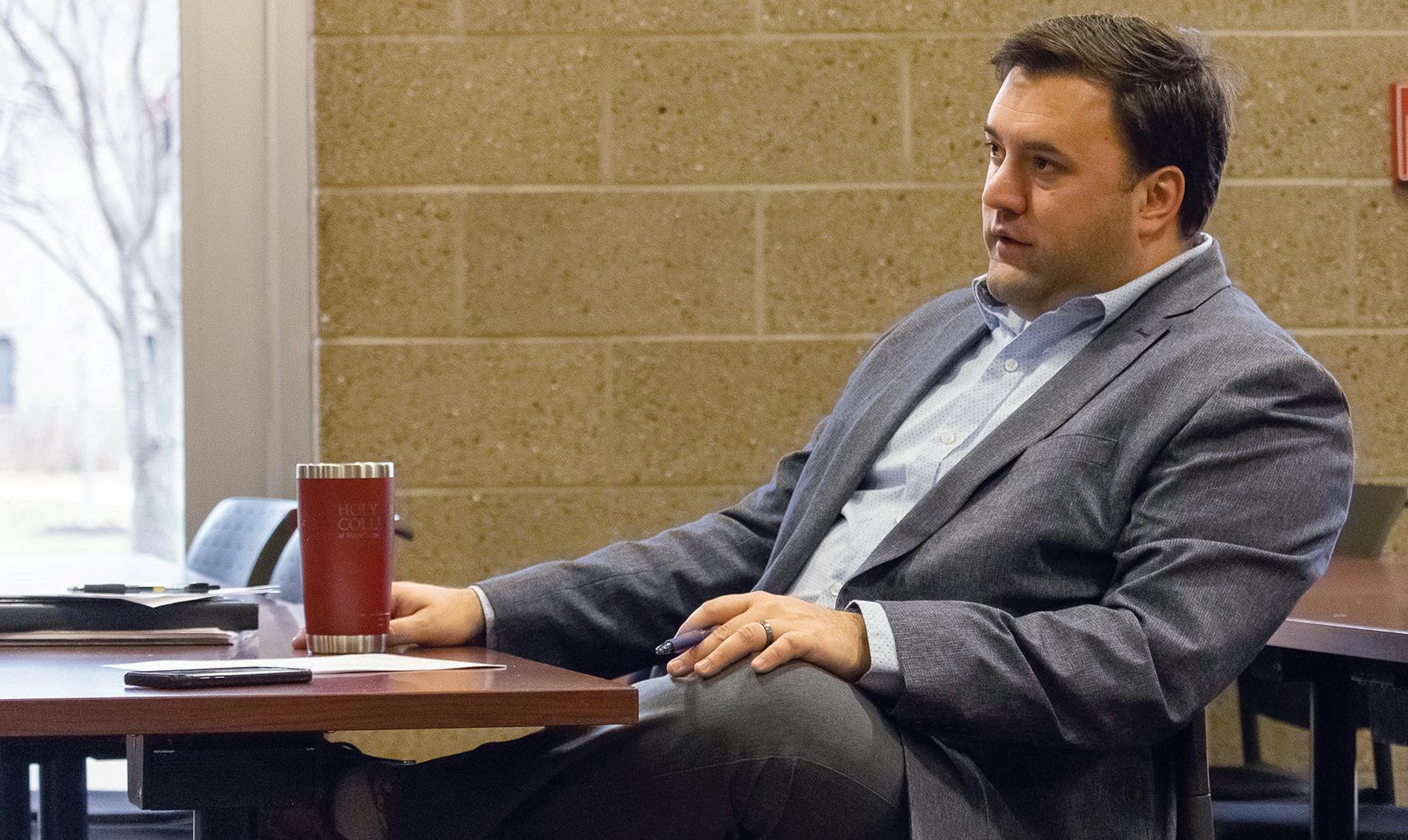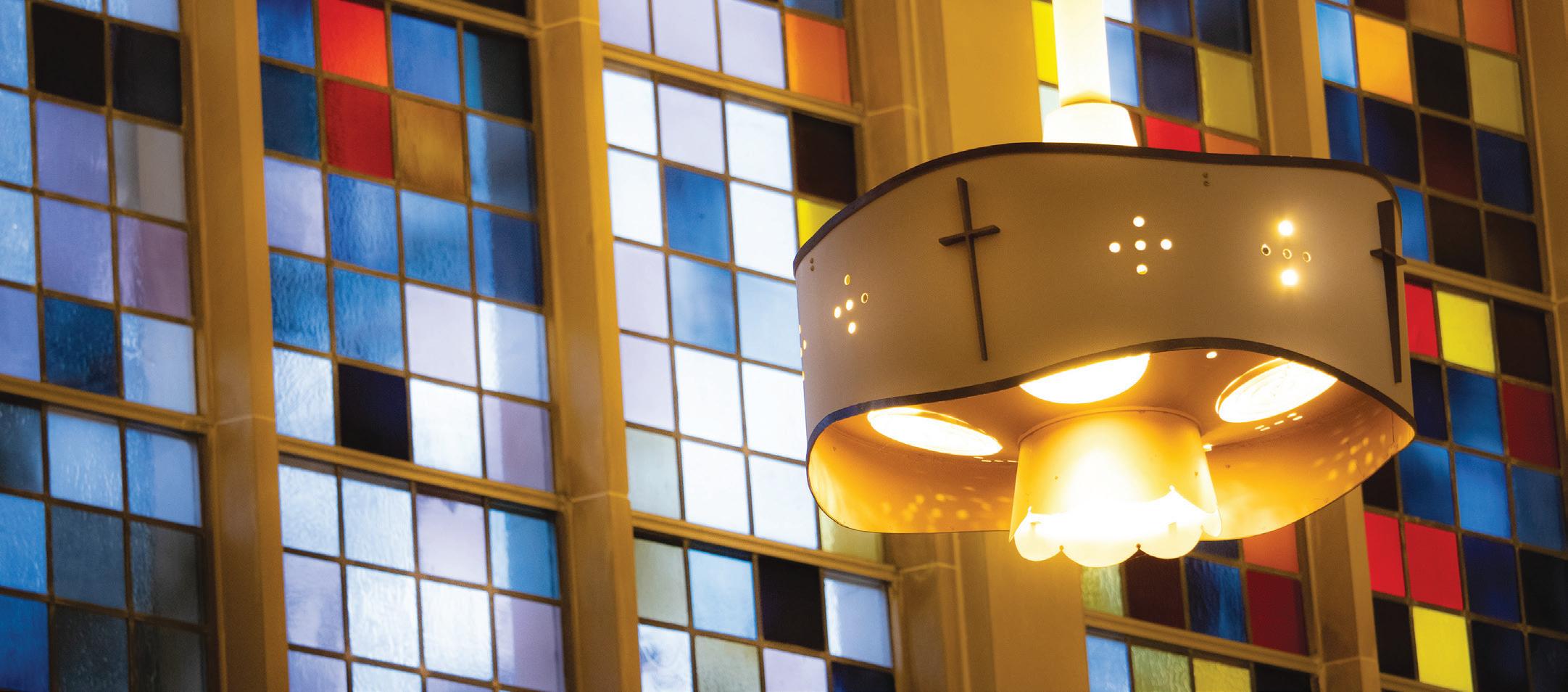
9 minute read
Faculty Updates
The Department of Mathematics and Computer Science welcome two new members
Deborah C. Arango,
Ph.D. joins the mathematics and computer science department at Holy Cross College. She received her master’s degree from Emory University and her doctoral degree from Utah State University. She has taught at Lenoir-Rhyne University; the University of Maryland University College, European Division; International College Beijing— University of Colorado Denver; the U.S. Air Force Academy; and Regis University. She received a fellowship and was a member of the Eric Roberts Initiative in Computer Science Education at Stanford University in 2016.
“I am committed to the idea that Holy Cross deserves to have a strong mathematics program so that we can be competitive and attract a wide range of students.To that end, working with the natural sciences and mathematics faculty,I am helping to develop a mathematics minor, and eventually I hope we will have a flourishing math major. I am also formulating other proposals which will help to strengthen and grow the math program such as starting a chapter of the American Mathematical Society, encouraging participation in the Math Club (with Math Game Night, and Math Olympiad-type tournaments, and tutoring in the community), and getting students involved in math research and attending conferences.”
“At the same time, since computer science is a discipline in great demand, I have formulated proposals to establish a computer science program here at Holy Cross,” noted Arango
We also welcome
Dennis
Vanderberg, who has taught mathematics at Holy Cross College for the past four years as an adjunct instructor, holds two master’s degrees—one in systems technology from the U.S. Naval Postgraduate School in Monterey, California, and another in applied mathematics from Indiana University. Vandenberg served previously as a cryptologic naval officer and has taught finite mathematics, statistics, calculus and algebra at Indiana University South Bend, Saint Mary’s College, Purdue Polytechnic South Bend, and Southwestern Michigan College.
Angelo Ray Martínez begins tenure-track at Holy Cross College
A nationwide search brought Assistant Professor and Chair of the Creative Arts Department Angelo Ray Martínez, Ph.D. to begin the role of a tenure-track faculty member at Holy Cross College. He began teaching at the college in the spring of 2017 and holds a Master of Fine Arts from the University of Illinois at UrbanaChampaign. Professor Martínez has also instructed art courses for Indiana University South Bend and Illinois State University.
“I love Holy Cross College and my role here, so I would like to continue growing professionally with the college,” noted Martínez. “ I plan on continue strengthening the visual arts program and supporting our students in developing successful careers in the arts.”
Professor Martínez curates the Saint Joseph Gallery on campus, rotating current works by the College’s students, faculty, and other guest artists.
The Department of English has two full-time faculty members.
Anthony Monta,
Ph.D. joins Holy Cross College as a full-time faculty member in the English department. He worked for the Nanovic Institute for European Studies in the Keough School of Global Affairs at the University of Notre Dame, serving as assistant director from 2007 to 2011 and as the associate director thereafter. He holds master’s and doctoral degrees in English literature
from the University of WisconsinMadison. Before moving to the Midwest, he taught English literature and composition at Louisiana State University. He also worked in the Division of Academic Affairs for the State of Louisiana Board of Regents.
We also welcome
Christopher R.J. Scheirer,
who earned a master’s and doctoral degree from the University of Notre Dame, both in Medieval studies. Before moving to Indiana, he earned a master of arts in English from North Carolina State University.
Natural Sciences receives a new instructor
Zhutian Zhang
joined the department of natural sciences. She received her Master of Science in chemistry from Case Western Reserve University in Cleveland, Ohio, where she is a Ph.D. candidate in computational and organic chemistry. She has been an adjunct instructor at Holy Cross since 2017.
New instructor added to the Teacher Education Program
Annette Romans
joins Holy Cross College as a fulltime instructor of elementary education in the Teacher Education Program. Romans earned her Master of Education through the Alliance for Catholic Education at the University of Notre Dame and completed her English as a New Language (ENL) certification at Holy Cross College.
She has worked for the past seven years at St. Adalbert Catholic School as a resource and ENL teacher. During her career, has served as an adjunct instructor at Holy Cross, teaching the Language Acquisition course, and is a two-time recipient of the Light of Learning Award from the Diocese of Fort Wayne-South Bend. She received the Maureen T. Hallinan Award for Excellence in Catholic Education from the University of Notre Dame.
Adjunct Instructor in Theology presents paper at conference
Andrew L.
Ouellette, Director of Campus Ministry and Adjunct Instructor in Theology, had the opportunity to present his paper “Signs and Symbols of the Supernatural World – Walker Percy’s Semiotic and His Sacramental World View” at the South Atlantic Modern Language Association (SAMLA) Conference.
“It was a paper on Walker Percy’s philosophy of language and symbols and it’s influence in the sacramental images of his novels,” said Ouellette.
The conference was held in Atlanta, Georgia, November 15-17, 2019. According to their website, SAMLA is an organization of teachers, scholars, and students dedicated to the advancement of literary and linguistic scholarship and teaching in the modern languages. It started as a regional organization that now extends throughout the southeastern United States, across the country, and around the world. SAMLA’s largest event is its annual conference.
Comprised of an extensive list of panels, events, and distinguished speakers, each conference continues to draw people from throughout the region and, increasingly, the world.
(continued on next page.)
(continued from previous page.)
Holy Cross Psychology Professor part of glucose study
Cosette Fox,
Ph.D., Associate Professor of Psychology, was a co-author of “The effect of glucose and emotional arousal on memory in young adults,” in the “Pedagogical Contexts Journal.”
Throughout her time as a graduate student, Fox studied the affects of glucose on the memory and how it works. Her interest is neuroscience and she was interested in how proteins in the brain bring sugar molecules to cells for memory. “How what we ingest affects our thinking and behavior,” she noted. And stressed the importance of sugars from fruits, dairy and vegetables on the memory found in her research.
The study also found memories with emotion, such as trauma induced or from a difficult life situation, are better recalled because they are emotionally charged. It did not find that glucose helps retain emotional memory.
This paper was written while Fox was working at another institution. With the assistance of Holy Cross students, a research project has been conducted on campus with the hopes of publication of the results in the near future.
Alesha Seroczynski,
Ph.D., Director of the Moreau College Initiative, was a contributor to “Becoming Vulnerable with the Vulnerable: A Pedagogy of Hope for Incarcerated Students of the Liberal Arts” in the book “Pedagogy of Vulnerability.”
According to co-author Maria McKenna, Ph.D. at the University of Notre Dame, “our goal with the book was to provide a vision for higher education embracing the heart and mind, emotion and reason. Our contributors shared the heart of their teaching and supported their pedagogical visions with theory and practice. We hope the collection inspires other educators to reflect on their own practice in novel ways and supports a more inclusive vision for higher education.”
History professor combines his love of the subject to a creative outlet
Thomas Spencer,
Ph.D., Associate Professor of History, finds research and writing a creative outlet that is both professionally and personally rewarding. His recent published pieces include the book review “Roosevelt’s Company Man: The Political Career of J. Bruce Kremer,” in “Montana: The Magazine of Western History” about the book “Frank and Al: FDR, Al Smith and the Unlikely Alliance that Created the Modern Democratic Party” by Terry Golway and “One of Tom’s Guardian Angels:” review of “Called to Serve: the Untold Story of Father Irenaeus Herscher, OFM,” that appeared in The Merton Seasonal: A Quarterly Review.
“My interest in the political history of the New Deal era stemmed from the influence of my mentor and adviser when in graduate school at Notre Dame, Rev. Thomas Blantz, CSC. Fr. Blantz was an inspiration to me as a scholar and teacher and much of what I have pursued in my research as well as what I do in the classroom stems from his influence early on my graduate career.
I enjoy people and most of my research and writing involves people as opposed to policies or events. I am a believer in the adage that “ all history is human history.”
So much of my research and publication has involved people, their political careers, contributions, etc.,” noted Spencer.
Spencer hopes that readers get an appreciation of history—how we can learn much about ourselves and the present by studying the past.
Department Chair of Creative Arts shares creativity with the community
Angelo Ray Martinez, Ph.D., Assistant Professor and Department Chair Creative Arts, brought his creativity out of the classroom and put it on display through exhibitions and publications. His exhibitions included: “Open World: Video Games and Contemporary Art,” at the Akron Art Museum, Akron, Ohio; “Water Shapes” at Spark Lab - Fed Galleries, Kendall College of Art and Design at Ferris State University, Grand Rapids, Michigan; “While Supplies Last” at the Bellevue Arts Museum, Bellevue, Washington; “ GIFC / Velvet Ropes” in the Nevven Gallery, Gothenburg, Sweden; “GIFC / Velvet Ropes” in the Galleri Golsa @ Dora Sjøsiden, Trondheim, Norway; the Holy Cross College faculty/staff exhibition in the Saint Joseph Gallery at Holy Cross College, Notre Dame, Indiana; and “You Are Standing on a Prehistoric Ocean” at the Sandusky Cultural Center, Sandusky, Ohio. He was personally invited by the curator of each exhibition that he took part in last year.
“I expect most viewers to engage with my work in a variety of different ways, depending on their own lived experience. Some may experience the imagery with a sense of nostalgia, while others interpret the images as foreign or distant. However, my intention is to create a visual experience that questions the mode in which video games represent the nuances of ‘real life’ through the digital platform of simulated experience,” noted Martinez.
His publication work in 2019 included his work being featured in the book “Open World: Video games and Contemporary Art,” “Open World: Akron Art Museum Explores the Influence on Video games on Contemporary Art” in Juxtapoz Magazine and “Video Games” in Art In America.
“Within my paintings, I combine a playful variety of images, exploring the construction of personal and cultural identities. 8-bit video game graphics, tattoos, and items of clothing are some of the elements that I utilize to explore themes of appropriation, assimilation, and hybridity. My work questions the role of reproducible objects and images in the construction of self-identification while highlighting the increasing fluidity of identity in the post-internet age,” said Martinez.
“I am inspired by other artists that explore the effect that digital technology has on ‘real-life,’ non-digital, experiences. I am intrigued by the ways in which simulated, virtual, and digital, interactions reflect ‘real-life’ experiences, but also affect the ‘real-world,’ altering our perception of the world around us.Visually, I am drawn to contradictory images that merge flat, graphic imagery, such as early video games and traditional tattoos, with more traditional forms of representation,” he continued.











